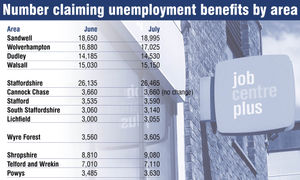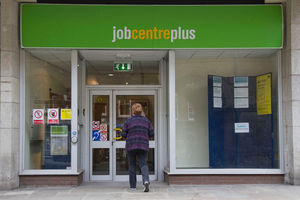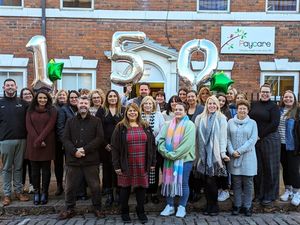Number claiming unemployment benefits in the West Midlands rises
The number of people claiming unemployment benefits in the region has risen, new figures show.
In the West Midlands the amount of people claiming unemployment benefits, including Universal Credit, grew by 4,480 last month to 266,830 – 7.3 per cent of the working population.
Dudley saw a rise of 345 claimants to 14,530 (7.5 per cent), Sandwell was up by the same number to 18,995 (9.3 per cent).
In Wolverhampton there were 145 more claimants at 17,025 (10.4 per cent) and Walsall was up 120 to 15,150 (8.8 per cent).
For Staffordshire the claimants total rose by 330 to 26,465. Cannock Chase saw no rise at 3,660 (5.8 per cent), but there were rises of 80 in South Staffordshire to 3,140 (4.7 per cent), 55 in Stafford to 3,590 (4.4 per cent) and 55 in Lichfield to 3,065 (five per cent).

Wyre Forest, including Kidderminster, saw a rise of 45 to 3,605 (6.6 per cent).
Shropshire's claimant total rose by 270 to 9,080 (4.8 per cent) and Telford and Wrekin was up 100 at 7,110 (6.4 per cent),
In Powys there were 145 more claimants at 3,630 (4.8 per cent).
New data from the Office for National Statistics shows that around 730,000 UK workers have been removed from the payrolls of British companies since March when the coronavirus lockdown began.
Yet the official UK unemployment rate – 3.9 per cent – is not rising. This is because to be counted among the unemployed, workers need to be actively looking for a new job, which many have decided not to do yet, the ONS said.
However, this does not mean that the people in question do not want a job, said Jonathan Athow, the ONS's deputy national statistician for economic statistics.
Official unemployment figures show a fall in the West Midlands in the three months to the end of June.
The number out of work was down from 143,000 for the March to May period to 130,000 – 4.4 per cent of the working population.
Numbers in employment in the region were up from 2.809 million to 2.819m – 60 per cent, but nationally employment rates have continued to decline in the last month, as another 81,000 jobs fell off payrolls across the country.
"Figures from our main survey show there has been a rise in people without a job and not looking for one, though wanting to work," Mr Athow said.
"In addition, there are still a large number of people who say they are working no hours and getting zero pay."
Between May and June employment dropped by the largest amount in a quarter since 2009.
The over-65s, the self-employed and part-time workers were especially badly hit.
Meanwhile, the number of hours worked by British employees has dropped to record lows.
The ONS said that around 7.5 million people were estimated to be temporarily away from work in June this year, most of them on the Government's furlough scheme.
Around three million of these had been away for three months or more.
And around 300,000 people in the UK were away from work because of the pandemic but getting no pay last month, the statisticians revealed.

Mr Athow added: "The labour market continues recent trends, with a fall in employment and significantly reduced hours of work as many people are furloughed.
"The falls in employment are greatest among the youngest and oldest workers, along with those in lower-skilled jobs.
"Vacancies numbers began to recover in July, especially in small businesses and sectors such as hospitality, but demand for workers remains depressed."
The worst of the job losses came in the beginning of the lockdown months. Many people were taken off payrolls as large parts of the economy ground to a halt in late March when Prime Minister Boris Johnson told everyone to only leave their homes to exercise or get food.
Between March and June UK workers on company payrolls dropped by 649,000, according to ONS data released last month. Most of that was weighted towards the early days of lockdown.
Experts are worried that the full extent of Britain's jobs problems has been hidden by the Government's furlough scheme, which promised to cover 80 per cent of the salaries of staff who could not work because of lockdown.
These furloughed workers are still considered to be employed, but many worry they will have no job to come back to when the scheme winds down.
The furlough scheme ends in October, though the Government has promised a £1,000 per employee bonus to any company that brings back furloughed staff and keeps paying them until January.
"While the headline data continues to lag behind the reality on the ground, the decline in the number of employees on payrolls and hours worked is further evidence of the damage being done to the UK labour market by the coronavirus pandemic," said Suren Thiru, the head of economics at the British Chambers of Commerce.
"The furlough scheme has been successful in preserving millions of jobs.

"However, with firms continuing to face a perfect storm of increased costs, reduced demand, and diminished cash reserves, unemployment is likely to surge as the Government support schemes wind down, unless action is taken."
Minister for Employment Mims Davies said: “Today’s figures show more of the impact the virus is having on both our economy and labour market meaning many people will be understandably concerned about the future – which is why we’ve set out our Plan for Jobs, to protect, create and support jobs as we build back our economy.
“We’ve already protected more than 9.5m jobs throughout this period with the furlough scheme, supported more than two million self-employed people and paid out billions in loans and grants to thousands of businesses. Our Eat Out to Help Out scheme is supporting thousands of jobs in the hospitality sector and helping boost confidence, and the key cut to stamp duty has led to a surge in house sales and a welcome boost to the economy.
“Looking to the future, next month we’re launching the £2 billion Kickstart scheme to create thousands of new high quality jobs for young people, increasing access to tailored job support by doubling the number of work coaches across the UK and we are boosting the DWP Flexible Support Fund by £150 million to provide vital localised employment support. We are determined to build back stronger and support people as we move into recovery.”
British Chamber of Commerce head of economics Suren Thiru said: "While the headline data continues to lag behind the reality on the ground, the decline in the number of employees on payrolls and hours worked is further evidence of the damage being done to the UK labour market by the coronavirus pandemic.
“The furlough scheme has been successful in preserving millions of jobs. However, with firms continuing to face a perfect storm of increased costs, reduced demand, and diminished cash reserves, unemployment is likely to surge as the government support schemes wind down, unless action is taken.
“A significant spike in job losses would be a major drag on any recovery, stifling consumer spending and reducing the productive capacity of the UK economy.
“To help businesses recruit and retain staff, more needs to be done to reduce the overall cost of employment and prevent substantial redundancies. This could include significant expansion of the Employment Allowance and a cut in employer National Insurance Contributions.”
Matthew Percival, Confederation of British Industry director for people and skills, said: “This data shows the devastating mark left on the labour market by the coronavirus crisis. With the UK under stringent lockdown measures to contain the virus in the quarter to June, fall in jobs and hours worked is to be expected.
"More positively, there is a small rise in vacancies, particularly in the hospitality sector as restrictions were relaxed.
“As local lockdowns become more common, the nature of support for businesses and people will need to evolve. Stepping up test and trace efforts will also be essential to minimise disruption in affected areas.”





